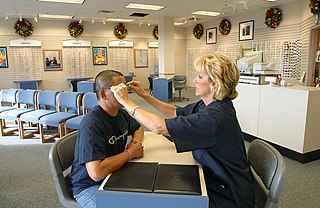Related Research Articles

Glasses, also known as eyeglasses and spectacles, are vision eyewear with clear or tinted lenses mounted in a frame that holds them in front of a person's eyes, typically utilizing a bridge over the nose and hinged arms, known as temples or temple pieces, that rest over the ears.

Myopia, also known as near-sightedness and short-sightedness, is an eye disease where light from distant objects focuses in front of, instead of on, the retina. As a result, distant objects appear blurry while close objects appear normal. Other symptoms may include headaches and eye strain. Severe myopia is associated with an increased risk of macular degeneration, retinal detachment, cataracts, and glaucoma.

A dioptre or diopter, symbol dpt, is a unit of measurement with dimension of reciprocal length, equivalent to one reciprocal metre, 1 dpt = 1 m−1. It is normally used to express the optical power of a lens or curved mirror, which is a physical quantity equal to the reciprocal of the focal length, expressed in metres. For example, a 3-dioptre lens brings parallel rays of light to focus at 1⁄3 metre. A flat window has an optical power of zero dioptres, as it does not cause light to converge or diverge. Dioptres are also sometimes used for other reciprocals of distance, particularly radii of curvature and the vergence of optical beams.

Optometry is a specialized health care profession that involves examining the eyes and related structures for defects or abnormalities. Optometrists are health care professionals who typically provide comprehensive eye care.

Presbyopia is physiological insufficiency of accommodation associated with the aging of the eye that results in progressively worsening ability to focus clearly on close objects. Also known as age-related farsightedness, it affects many adults over the age of 40. A common sign of presbyopia is difficulty reading small print which results in having to hold reading material farther away. Other symptoms associated can be headaches and eyestrain. Different people will have different degrees of problems. Other types of refractive errors may exist at the same time as presbyopia. This condition is similar to hypermetropia or far-sightedness which starts in childhood and exhibits similar symptoms of blur in the vision for close objects.

An eyeglass prescription is an order written by an eyewear prescriber, such as an optometrist, that specifies the value of all parameters the prescriber has deemed necessary to construct and/or dispense corrective lenses appropriate for a patient. If an eye examination indicates that corrective lenses are appropriate, the prescriber generally provides the patient with an eyewear prescription at the conclusion of the exam.

An optician is an individual who fits eyeglasses or contact lenses by filling a refractive prescription from an optometrist or ophthalmologist. They are able to translate and adapt ophthalmic prescriptions, dispense products, and work with accessories. There are several specialties within the field.

Refractive error is a problem with focusing light accurately on the retina due to the shape of the eye and/or cornea. The most common types of refractive error are near-sightedness, far-sightedness, astigmatism, and presbyopia. Near-sightedness results in far away objects being blurry, far-sightedness and presbyopia result in close objects being blurry, and astigmatism causes objects to appear stretched out or blurry. Other symptoms may include double vision, headaches, and eye strain.

Orthokeratology, also referred to as Night lenses, Ortho-K, OK, Overnight Vision Correction, Corneal Refractive Therapy (CRT), Accelerated Orthokeretology, Cornea Corrective Contacts, Eccentricity Zero Molding, and Gentle Vision Shaping System (GVSS), is the use of gas-permeable contact lenses that temporarily reshape the cornea to reduce refractive errors such as myopia, hyperopia, and astigmatism.
Vision therapy (VT), or behavioral optometry, is an umbrella term for alternative medicine treatments using eye exercises, based around the pseudoscientific claim that vision problems are the true underlying cause of learning difficulties, particularly in children. Vision therapy has not been shown to be effective using scientific studies, except for helping with convergence insufficiency. Most claims—for example that the therapy can address neurological, educational, and spatial difficulties—lack supporting evidence. Neither the American Academy of Pediatrics nor the American Academy of Ophthalmology support the use of vision therapy.
The General Optical Council (GOC) is an organisation in the United Kingdom which maintains a register of opticians and regulates the services provided by dispensing opticians and optometrists. The stated function of the GOC is "to protect the public and promote high standards of professional conduct and education amongst opticians".

Essilor International is an international ophthalmic optics company that designs, manufactures and markets lenses to correct or protect eyesight. Its headquarters is in Charenton-le-Pont, France.
An eye care professional is an individual who provides a service related to the eyes or vision. It is any healthcare worker involved in eye care, from one with a small amount of post-secondary training to practitioners with a doctoral level of education.
Optometry is a health care profession that provides comprehensive eye and vision care, which includes the diagnosis and management of eye diseases.
Keith Clifford Hall was a British ophthalmic optician and pioneer of contact lenses.
The Brien Holden Vision Institute (BHVI) is an Australian nonprofit non-governmental organization with an international focus on eye care research and vision care delivery. Formerly the Institute for Eye Research, in 2010, it was renamed in recognition of co-founder and optometrist Professor Brien Holden OAM, a 1997 recipient of the Medal of the Order of Australia for his contributions to eye care research.
The Optical Confederation is a British trade association launched in April 2010. It is said to help the optometric profession to "punch well above its weight". Lobbying is one of its key activities. It agrees on advice to opticians with the Department of Health about the administration of NHS sight tests and what fees practitioners can claim. It also issues guidance on professional issues which apply to the entire optical sector, such as the prevention of abuse of vulnerable patients.
Heiko Pult is a German research optometrist, specialising in research in dry eye, contact lenses, tear film and visual acuity. He is the CEO of Horst Riede GmbH in Weinheim, Germany, and also heads a research group, Dr Heiko Pult - Optometry and Vision Research, also based in Weinheim. He is also Professor at Cardiff University, lecturer and author of numerous papers, articles and books.

The European Academy of Optometry and Optics (EAOO) is a membership organization for the development of optometry and optics in Europe. It aims to help in advancing scientific knowledge and learning for optometrists, opticians, and vision scientists, within Europe.
Jennifer P. Craig is a Scottish–New Zealand academic optometrist, and is a full professor at the University of Auckland, specialising in ocular surface disease.
References
- ↑ Association, British Contact Lens. "Home". www.bcla.org.uk. Retrieved 23 September 2018.
- ↑ "Myopia management and presbyopia correction at the BCLA". Optician Online. 6 July 2015. Retrieved 17 July 2015.
- ↑ "New frontiers in contact lenses". Optometry Today. 8 July 2015. Archived from the original on 21 July 2015. Retrieved 17 July 2015.
- ↑ "BCLA in new partnership to run Netherlands symposium". Optometry Today. 23 June 2015. Archived from the original on 21 July 2015. Retrieved 17 July 2015.
- ↑ "BCLA President". www.bcla.org.uk. Retrieved 4 May 2022.
- 1 2 "Meet the Global Ambassadors". British Contact Lens Association. Retrieved 1 July 2024.